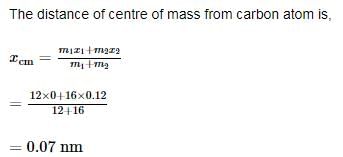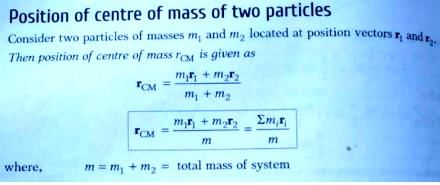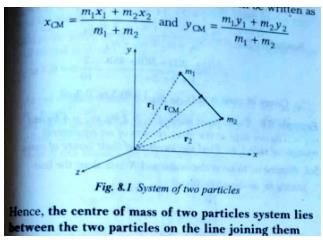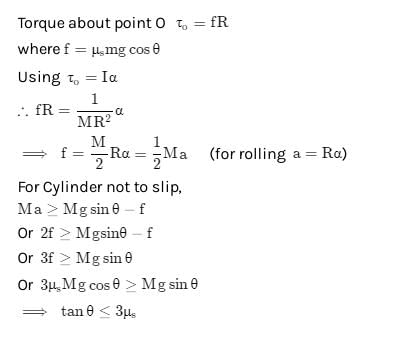All Exams >
NEET >
NCERT Based Tests for NEET >
All Questions
All questions of System of Particles and Rotational Motion for NEET Exam
The centre of mass of a body is locateda)outside the systemb)inside or outside the systemc)inside the systemd)at the centre of systemCorrect answer is option 'B'. Can you explain this answer?
|
|
Suresh Iyer answered |
The centre of mass of a body can lie within or outside the body.
Example
(i) Centre of mass of a uniform rod lies at its geometrical centre which lies within the rod
(ii) Centre of mass of a uniform ring lies at its geometrical centre which lies outside the ring.
Example
(i) Centre of mass of a uniform rod lies at its geometrical centre which lies within the rod
(ii) Centre of mass of a uniform ring lies at its geometrical centre which lies outside the ring.
Can you explain the answer of this question below:Two blocks of the masses 10 kg and 4 kg are connected by a spring of negligible mass and placed on a frictionless horizontal surface. An impulse gives a velocity of 14 m/s to the heavier block. The velocity of centre of mass is
- A:
10 m/s
- B:
5 m/s
- C:
15 m/s
- D:
20 m/s
The answer is a.
Two blocks of the masses 10 kg and 4 kg are connected by a spring of negligible mass and placed on a frictionless horizontal surface. An impulse gives a velocity of 14 m/s to the heavier block. The velocity of centre of mass is
10 m/s
5 m/s
15 m/s
20 m/s

|
EduRev JEE answered |
Velocity of heavier block (v2) = 14m/s
Velocity of lighter block (v1) = 0m/s
Velocity of centre of mass,

Velocity of lighter block (v1) = 0m/s
Velocity of centre of mass,


Which of the following relations is wrong?- a)

- b)

- c)

- d)

Correct answer is option 'D'. Can you explain this answer?
Which of the following relations is wrong?
a)
b)
c)
d)
|
|
Gaurav Kumar answered |
Just like the equations of motion in 1D, we get the equations of motion for rotation.
We know that s = d/t, analogous to it is
Hence D is the correct answer.
We know that s = d/t, analogous to it is
Hence D is the correct answer.
A mass m is moving with a constant velocity along a line parallel to the x-axis, away from the origin. Its angular momentum with respect to the origin
- a)Is zero
- b)Remains constant
- c)Goes on increasing
- d)Goes on decreasing
Correct answer is option 'B'. Can you explain this answer?
A mass m is moving with a constant velocity along a line parallel to the x-axis, away from the origin. Its angular momentum with respect to the origin
a)
Is zero
b)
Remains constant
c)
Goes on increasing
d)
Goes on decreasing
|
|
Krishna Iyer answered |
Angular momentum (L) is defined as the distance of the object from a rotation axis multiplied by the linear momentum
L = mv×y
L = mv×y

As the particle moves, m; v; and y, all remain unchanged at any point of time
⇒ L = constant
⇒ L = constant
A person standing on a rotating platform with his hands lowered outstretches his arms. The angular momentum of the person- a)becomes zero
- b)decreases
- c)remains constant
- d)inreases
Correct answer is option 'C'. Can you explain this answer?
A person standing on a rotating platform with his hands lowered outstretches his arms. The angular momentum of the person
a)
becomes zero
b)
decreases
c)
remains constant
d)
inreases
|
|
Suresh Reddy answered |
Yes because there is absence of any external force or torque so angular momentum will remain constant
here outstretching the hands means internal forces are working.. so moment of inertia increases in this case and to make angular momentum constant when angular velocity decreases.
here outstretching the hands means internal forces are working.. so moment of inertia increases in this case and to make angular momentum constant when angular velocity decreases.
There are two objects of masses 1 kg and 2 kg located at (1, 2) and (-1, 3) respectively. The coordinates of the centre of mass are- a)( 2, -1 )
- b)( 8/3 ,-1/3 )
- c)( -1/3 , 8/3 )
- d)none of these
Correct answer is option 'C'. Can you explain this answer?
There are two objects of masses 1 kg and 2 kg located at (1, 2) and (-1, 3) respectively. The coordinates of the centre of mass are
a)
( 2, -1 )
b)
( 8/3 ,-1/3 )
c)
( -1/3 , 8/3 )
d)
none of these
|
|
Riya Banerjee answered |
Body A has mass of 1kg and location (1,2)
Body B has mass of 2kg and location (-1,3)
Body B has mass of 2kg and location (-1,3)
mcxc = m1x1 + m2x2
(1+2) xc = (1 * 1) + (2 * -1)
xc = -1/3
(1+2) xc = (1 * 1) + (2 * -1)
xc = -1/3
Similarly,
mcyc = m1y1 + m2y2
(1 + 2) yc = (1 * 2) + (2 * 3)
yc= 8/3
mcyc = m1y1 + m2y2
(1 + 2) yc = (1 * 2) + (2 * 3)
yc= 8/3
Hence, the coordinates of the center of mass are (-1/3, 8/3).
The moment of inertia of two spheres of equal masses is equal. If one of the spheres is solid of radius  m and the other is a hollow sphere. What is the radius of the hollow sphere?
m and the other is a hollow sphere. What is the radius of the hollow sphere?- a)5 m
- b)√3 m
- c)3√3 m
- d)3 m
Correct answer is option 'C'. Can you explain this answer?
The moment of inertia of two spheres of equal masses is equal. If one of the spheres is solid of radius  m and the other is a hollow sphere. What is the radius of the hollow sphere?
m and the other is a hollow sphere. What is the radius of the hollow sphere?
 m and the other is a hollow sphere. What is the radius of the hollow sphere?
m and the other is a hollow sphere. What is the radius of the hollow sphere?a)
5 m
b)
√3 m
c)
3√3 m
d)
3 m

|
Sushil Kumar answered |
Moment of inertia of solid sphere Is= 2/5MR2
moment of inertia of hollow sphere Ih =2/3MR2
given mass of solid sphere =√45 kg.
Is=Ih
2MR2/5=2MR2/3
given their masses are equal 2 (√45)2/5= 2 R2/3
45/5=R2/3
9=R2/3
9×3=R2
27=R2
√27=R
√3×9=R
3√3 m=R.
moment of inertia of hollow sphere Ih =2/3MR2
given mass of solid sphere =√45 kg.
Is=Ih
2MR2/5=2MR2/3
given their masses are equal 2 (√45)2/5= 2 R2/3
45/5=R2/3
9=R2/3
9×3=R2
27=R2
√27=R
√3×9=R
3√3 m=R.
A right triangular plate ABC of mass m is free to rotate in the vertical plane about a fixed horizontal axis through A. It is supported by a string such that the side AB is horizontal. The reaction at the support A is : 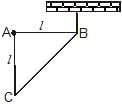
- a)

- b)

- c)

- d)mg
Correct answer is option 'B'. Can you explain this answer?
A right triangular plate ABC of mass m is free to rotate in the vertical plane about a fixed horizontal axis through A. It is supported by a string such that the side AB is horizontal. The reaction at the support A is :
a)
b)
c)
d)
mg

|
Crafty Classes answered |
The distance of Centre Of Mass of the given right angled triangle is 2L/3 along BA and L/3 along AC from the point B.
Force of magnitude mg is acting downwards at its COM.
Moment balance around B gives:
mg(2L/3)−FA(L)=0
(Moment= × =rFsin(θ)=F(rsin(θ))=Fr⊥)
∴FA=2mg/3
Force of magnitude mg is acting downwards at its COM.
Moment balance around B gives:
mg(2L/3)−FA(L)=0
(Moment= × =rFsin(θ)=F(rsin(θ))=Fr⊥)
∴FA=2mg/3
The motion of a potter’s wheel is an example of
- a)rolling motion
- b)rotatory motion
- c)translatory motion
- d)precessional motion
Correct answer is option 'B'. Can you explain this answer?
The motion of a potter’s wheel is an example of
a)
rolling motion
b)
rotatory motion
c)
translatory motion
d)
precessional motion
|
|
Anjali Iyer answered |
Potter’s wheel is an example of rotary motion. Rotary motion is that kind of motion in which body of the mass moves along a circular path about an axis which remains fixed.
The centre of mass of a system of particles does not depend on
- a)masses of the particles
- b)forces on the particles
- c)relative distances between the particles
- d)position of the particles
Correct answer is option 'B'. Can you explain this answer?
The centre of mass of a system of particles does not depend on
a)
masses of the particles
b)
forces on the particles
c)
relative distances between the particles
d)
position of the particles
|
|
Neha Joshi answered |
The resultant of all forces, on any system of particles, is zero. Therefore, their centre of mass does not depend upon the forces acting on the particles.
An engine develops a power of 360 kw, when rotating at 30 revolutions per second. The Torque required to deliver this power is- a)191.08 Nm
- b)19108 Nm
- c)1910.8 Nm
- d)19.108 Nm
Correct answer is option 'C'. Can you explain this answer?
An engine develops a power of 360 kw, when rotating at 30 revolutions per second. The Torque required to deliver this power is
a)
191.08 Nm
b)
19108 Nm
c)
1910.8 Nm
d)
19.108 Nm
|
|
Preeti Iyer answered |
The power delivered by the torque τ exerted on rotating body is given by
P=τω or τ=P/ω
Here P=360KW=360000 Watt
ω=30 x 2π rad/sec,
ω=60π rad/sec
now,
τ=360000 /60×3.14Nm
τ= 1910.8 Nm
P=τω or τ=P/ω
Here P=360KW=360000 Watt
ω=30 x 2π rad/sec,
ω=60π rad/sec
now,
τ=360000 /60×3.14Nm
τ= 1910.8 Nm
A body is moving with a constant speed v in a circle of radius r. What is the angular acceleration?- a)α = vt/r
- b)α = vr/t
- c)α = v/rt
- d)α = 0
Correct answer is option 'D'. Can you explain this answer?
A body is moving with a constant speed v in a circle of radius r. What is the angular acceleration?
a)
α = vt/r
b)
α = vr/t
c)
α = v/rt
d)
α = 0
|
|
Abhishek Pandey answered |
When a body performs circular motion it has got two accelerations radial acc. And tangential acc. Radial acc. Is responsible for changing the direction of velocity of body but tangential acc. Is responsible for changing the magnitide of velocity of body. As the body is moving with constant speed so tangential acc. Is zero. As we know that tangential acc. = radius * angular acc. So angular acc.is zero.
A circus acrobat while performing spins brings his limbs closer to the body. Due to this- a)Moment of inertia increases and angular velocity increases
- b)Moment of inertia decreases and angular velocity decreases
- c)Moment of inertia increases and angular velocity decreases
- d)Moment of inertia decreases and angular velocity increases
Correct answer is option 'D'. Can you explain this answer?
A circus acrobat while performing spins brings his limbs closer to the body. Due to this
a)
Moment of inertia increases and angular velocity increases
b)
Moment of inertia decreases and angular velocity decreases
c)
Moment of inertia increases and angular velocity decreases
d)
Moment of inertia decreases and angular velocity increases

|
Akshay Shah answered |
While in the pike position the body decreases in radius as each segment moves closer to the axis of rotation, resulting in angular velocity increasing and a decrease of moment of inertia. Thus, during a dive, angular momentum is constant meaning that moment of inertia is inversely proportional to angular velocity.
If a shell at rest explodes then the centre of mass of the fragments
- a)remains at rest
- b)Moves along a parabolic path
- c)Moves along a straight line
- d)moves along an elliptical path
Correct answer is option 'A'. Can you explain this answer?
If a shell at rest explodes then the centre of mass of the fragments
a)
remains at rest
b)
Moves along a parabolic path
c)
Moves along a straight line
d)
moves along an elliptical path
|
|
Gaurav Kumar answered |
As a shell explosion is not governed by any external force, we get that no external force acts upon the shell, and hence it remains at rest.
The mass of an electron is  kg. It revolves around the nucleus of an atom in a circular orbit of radius 4.5 Å, with a speed of
kg. It revolves around the nucleus of an atom in a circular orbit of radius 4.5 Å, with a speed of  m/s. The angular momentum of electron is
m/s. The angular momentum of electron is- a)2.24 x 10-4 kgm2s-1
- b)3.24 x 10-34 kgm2s-1
- c)4.24 x10-34 kgm2s-1
- d)2.24 x 10-34 kgm2s-1
Correct answer is option 'B'. Can you explain this answer?
The mass of an electron is  kg. It revolves around the nucleus of an atom in a circular orbit of radius 4.5 Å, with a speed of
kg. It revolves around the nucleus of an atom in a circular orbit of radius 4.5 Å, with a speed of  m/s. The angular momentum of electron is
m/s. The angular momentum of electron is
 kg. It revolves around the nucleus of an atom in a circular orbit of radius 4.5 Å, with a speed of
kg. It revolves around the nucleus of an atom in a circular orbit of radius 4.5 Å, with a speed of  m/s. The angular momentum of electron is
m/s. The angular momentum of electron isa)
2.24 x 10-4 kgm2s-1
b)
3.24 x 10-34 kgm2s-1
c)
4.24 x10-34 kgm2s-1
d)
2.24 x 10-34 kgm2s-1
|
|
Krishna Iyer answered |
M=9x10-31Kg,r=4.5x10-10
V=8x105m/s
L=mvr
=9x10-31 x 4.5 x 10-10 x 8 x 105 = 3.24 x 10-34 kgm2s-1
V=8x105m/s
L=mvr
=9x10-31 x 4.5 x 10-10 x 8 x 105 = 3.24 x 10-34 kgm2s-1
Two rings have their moment of inertia in the ratio 2:1 and their diameters are in the ratio 2:1. The ratio of their masses will be:- a)1:2
- b)2:1
- c)1:4
- d)1:1
Correct answer is option 'A'. Can you explain this answer?
Two rings have their moment of inertia in the ratio 2:1 and their diameters are in the ratio 2:1. The ratio of their masses will be:
a)
1:2
b)
2:1
c)
1:4
d)
1:1
|
|
Suresh Reddy answered |
We know that MI of a ring is mr2
Where m is mass of the ring and r is its radius
When we have ratio of I = 2:1
And ratio of r = 2:1
We get ratio of r2 = 4:1
Thus to make this ratio 2:1 , that ratio of masses must be 1:2
Where m is mass of the ring and r is its radius
When we have ratio of I = 2:1
And ratio of r = 2:1
We get ratio of r2 = 4:1
Thus to make this ratio 2:1 , that ratio of masses must be 1:2
A rotating machine is maintained at a uniform angular speed of 150 rad s-1, with a torque of 100 Nm. The power is- a)15 kW
- b)1.5 kW
- c)1500 kW
- d)0.15 kW
Correct answer is option 'A'. Can you explain this answer?
A rotating machine is maintained at a uniform angular speed of 150 rad s-1, with a torque of 100 Nm. The power is
a)
15 kW
b)
1.5 kW
c)
1500 kW
d)
0.15 kW
|
|
Suresh Reddy answered |
Power = torque × angular velocity
P = 100 × 150
P = 15000 W
P = 15KW
P = 100 × 150
P = 15000 W
P = 15KW
If a man of mass M jumps to the ground from height h and his centre of mass moves a distance x in the time taken by him to hit the ground, the average force acting on him is (assuming his retardation to be constant during his impact with the ground)- a)

- b)

- c)

- d)

Correct answer is option 'B'. Can you explain this answer?
If a man of mass M jumps to the ground from height h and his centre of mass moves a distance x in the time taken by him to hit the ground, the average force acting on him is (assuming his retardation to be constant during his impact with the ground)
a)
b)
c)
d)
|
|
Neha Joshi answered |
As the center of mass moves through a distance x, the average force F acting on the man is calculated from :
Work done = Change in potential energy
⇒ Fx = Mgh
⇒ F =
Work done = Change in potential energy
⇒ Fx = Mgh
⇒ F =

In the pulley system shown, if radii of the bigger and smaller pulley are 2 m and 1 m respectively and the acceleration of block ‘A’ is 5 m/s2 in the downward direction , then the acceleration of block B will be :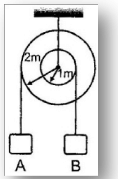
- a)0 m / s2
- b)5 m / s2
- c) 10 m / s2
- d) 5 / 2 m / s2
Correct answer is option 'D'. Can you explain this answer?
In the pulley system shown, if radii of the bigger and smaller pulley are 2 m and 1 m respectively and the acceleration of block ‘A’ is 5 m/s2 in the downward direction , then the acceleration of block B will be :
a)
0 m / s2
b)
5 m / s2
c)
10 m / s2
d)
5 / 2 m / s2
|
|
Anjali Sharma answered |
Since both pulley are connected to each other. So, their angular acceleration are equal.
⇒α1=α2⇒a1/ r1=a2/ r2 because α=a/r
⇒a1/1=5/2(Given, a2=5m/s2)
⇒a1=5/2 m/s2
Therefore, D is the correct option.
⇒α1=α2⇒a1/ r1=a2/ r2 because α=a/r
⇒a1/1=5/2(Given, a2=5m/s2)
⇒a1=5/2 m/s2
Therefore, D is the correct option.
There are two circular iron discs A and B having masses in the ratio 1:2 and diameter in the ratio 2:1. The ratio of their moment of inertia is- a)4:1
- b)1:3
- c)2:1
- d)8:1
Correct answer is option 'C'. Can you explain this answer?
There are two circular iron discs A and B having masses in the ratio 1:2 and diameter in the ratio 2:1. The ratio of their moment of inertia is
a)
4:1
b)
1:3
c)
2:1
d)
8:1
|
|
Preeti Iyer answered |
Given,
Mass of A=1,
Mass of B=2.
diameter if A=2,
diameter if B=1.
radius (r) of A=d/2=2/2=1.
radius (r) of B=d/2=1/2.
we know ,
moment of inertia of disc=MR2/2.
moment of inertia (I)of A/moment of inertia (I)of B=MR2/2/MR2/2.
(I) of A/(I) of B=1×12/2/2×(1/2)2/2.
=1×1/2/2×(1/4)/2.
=1/2/(1/2)/2.
=1/2/1/4.
=4/2.
=2/1.
Mass of A=1,
Mass of B=2.
diameter if A=2,
diameter if B=1.
radius (r) of A=d/2=2/2=1.
radius (r) of B=d/2=1/2.
we know ,
moment of inertia of disc=MR2/2.
moment of inertia (I)of A/moment of inertia (I)of B=MR2/2/MR2/2.
(I) of A/(I) of B=1×12/2/2×(1/2)2/2.
=1×1/2/2×(1/4)/2.
=1/2/(1/2)/2.
=1/2/1/4.
=4/2.
=2/1.
When external forces acting on a body are zero, then its centre of mass- a)remains stationary
- b)moves with uniform velocity
- c)either remains stationary or moves with uniform velocity
- d)none of these
Correct answer is option 'C'. Can you explain this answer?
When external forces acting on a body are zero, then its centre of mass
a)
remains stationary
b)
moves with uniform velocity
c)
either remains stationary or moves with uniform velocity
d)
none of these
|
|
Naina Sharma answered |
When force acting upon the body results zero, the resulting acceleration due to net force applied is also zero, and hence by the law of inertia the motion of the body either at rest or constant velocity wont change.
A homogeneous cubical brick lies motionless on a rough inclined surface. The half of the brick which applies greater pressure on the plane is : 
- a) Left half
- b)Right half
- c)Both applies equal pressure
- d)The answer depend upon coefficient of friction
Correct answer is option 'A'. Can you explain this answer?
A homogeneous cubical brick lies motionless on a rough inclined surface. The half of the brick which applies greater pressure on the plane is :
a)
Left half
b)
Right half
c)
Both applies equal pressure
d)
The answer depend upon coefficient of friction

|
Mohit Rajpoot answered |
As weight of the body (mg) acts along the left side i.e. mg sinx acts along flow of object.
mgcosx acts perpendicular to flow of the object.
The pressure of right half comes on left half hence left half has maximum pressure.
mgcosx acts perpendicular to flow of the object.
The pressure of right half comes on left half hence left half has maximum pressure.
There are some passengers inside a stationary railway compartment. The centre of masses of the compartment itself(without the passengers) is C1, while the centre of mass of the compartment plus passengers’ system is C2. if the passengers moves about inside the compartment
- a)both C1 and C2 will move with respect to the ground
- b)neither C1 nor C2 will move with respect to the ground
- c)C1 will move but C2 will be stationary with respect to the ground
- d)C2 will move but C1 will be stationary with respect to the ground
Correct answer is option 'C'. Can you explain this answer?
There are some passengers inside a stationary railway compartment. The centre of masses of the compartment itself(without the passengers) is C1, while the centre of mass of the compartment plus passengers’ system is C2. if the passengers moves about inside the compartment
a)
both C1 and C2 will move with respect to the ground
b)
neither C1 nor C2 will move with respect to the ground
c)
C1 will move but C2 will be stationary with respect to the ground
d)
C2 will move but C1 will be stationary with respect to the ground
|
|
Lavanya Menon answered |
When net Fexternal=0, then the centre of mass of the system remains at rest.
Thus if the passenger move inside the compartment which donot require any external force, so the centre of mass of the "passenger + compartment" system must remain at rest and hence C2 will be fixed w.r.t ground.
Also due to the movement of the passenger, the position of centre of mass of the passengers only will change, thus C1 will have to move in such a way that C2 may remain fixed w.r.t ground.
Can you explain the answer of this question below:The angular position of a particle (in radians), along a circle of radius 0.8 m is given by the function in time (seconds) by  . The linear velocity of the particle
. The linear velocity of the particle
- A:
1.84 m/s
- B:
1.80 m/s
- C:
1.82 m/s
- D:
1.88 m/s
The answer is a.
The angular position of a particle (in radians), along a circle of radius 0.8 m is given by the function in time (seconds) by  . The linear velocity of the particle
. The linear velocity of the particle
1.84 m/s
1.80 m/s
1.82 m/s
1.88 m/s

|
Knowledge Hub answered |
The answer is option A
So, as we know,
After differentiating angular velocity with respect to t,
Linear velocity=2t+2.3=ω
Now,
Velocity=r x ω(where r is 0.8m)
=0.8x2.3
=1.84m/s
So, as we know,
After differentiating angular velocity with respect to t,
Linear velocity=2t+2.3=ω
Now,
Velocity=r x ω(where r is 0.8m)
=0.8x2.3
=1.84m/s
Moment of inertia of a solid sphere of mass M and radius R is ______- a)MR2
- b)2/5MR2
- c)2/3MR2
- d)1/2MR2
Correct answer is option 'B'. Can you explain this answer?
Moment of inertia of a solid sphere of mass M and radius R is ______
a)
MR2
b)
2/5MR2
c)
2/3MR2
d)
1/2MR2
|
|
Sarita Pandey answered |
Moment of inertia of a solid sphere of mass M and radius R = 2/5 MR^2
A small cylinder rolling with a velocity v along a horizontal surface encounters a smooth inclined surface. The height ‘h’ up to which the cylinder will ascend is- a)3v2/4g
- b)v2/2g
- c)3v2/2g
- d)v2/4g
Correct answer is option 'B'. Can you explain this answer?
A small cylinder rolling with a velocity v along a horizontal surface encounters a smooth inclined surface. The height ‘h’ up to which the cylinder will ascend is
a)
3v2/4g
b)
v2/2g
c)
3v2/2g
d)
v2/4g
|
|
Shreya Gupta answered |
A body can roll along a surface only if the surface is rough. The body will roll up to the foot of the inclined smooth surface. It will continue to spin with the angular speed it has acquired, and will slide up to a certain height, maintaining its spin motion throughout the smooth surface. Its translational kinetic energy alone is responsible for its upward motion along the smooth incline so that the height up to which it will rise is given by


A rigid body is rotating about an axis. Different particles are at different distances from the axis. Which of the following is true?- a)Different particles possess the same angular acceleration
- b)Different particles possess the same angular velocity
- c)Different particles possess the same linear acceleration
- d)Different particles possess the same linear velocity.
Correct answer is option 'B'. Can you explain this answer?
A rigid body is rotating about an axis. Different particles are at different distances from the axis. Which of the following is true?
a)
Different particles possess the same angular acceleration
b)
Different particles possess the same angular velocity
c)
Different particles possess the same linear acceleration
d)
Different particles possess the same linear velocity.
|
|
Suresh Reddy answered |
In the fixed axis rotation we see that every point on the body has two components of velocity, one in the radial direction and one in the tangential direction. The resultant of these velocities is not the same for any two points lying in the plane of the body.
Any two points on the radial line have the radial acceleration directed towards the center of equal magnitude and the tangential acceleration of equal magnitude as well. Thus option B is correct.
All the particles lying on the curved surface of a cylinder whose axis coincides with the axis of rotation have the same speed but different velocities.
Any two points on the radial line have the radial acceleration directed towards the center of equal magnitude and the tangential acceleration of equal magnitude as well. Thus option B is correct.
All the particles lying on the curved surface of a cylinder whose axis coincides with the axis of rotation have the same speed but different velocities.
A solid sphere and a hollow sphere of the same mass have the same moments of inertia about their respective diameters, the ratio of their radii is- a)(5)1/2 : (3)1/2
- b) (3)1/2 : (5)1/2
- c)3 : 2
- d)2 : 3
Correct answer is option 'A'. Can you explain this answer?
A solid sphere and a hollow sphere of the same mass have the same moments of inertia about their respective diameters, the ratio of their radii is
a)
(5)1/2 : (3)1/2
b)
(3)1/2 : (5)1/2
c)
3 : 2
d)
2 : 3
|
|
Gaurav Kumar answered |
We know moment of inertia of solid sphere Is=2/5msRs2 and
moment of inertia of hollow sphere IH=2/3mHRH2 As per question Is=IH
Now,
2/5msRs2=2/3mHRH2
as the masses are equal the ratio of their radii will be
Rs2 /RH2 =2/3/2/5=√5/3=(5)1/2: (3)1/2
moment of inertia of hollow sphere IH=2/3mHRH2 As per question Is=IH
Now,
2/5msRs2=2/3mHRH2
as the masses are equal the ratio of their radii will be
Rs2 /RH2 =2/3/2/5=√5/3=(5)1/2: (3)1/2
A disc of radius b and mass m rolls down an inclined plane of vertical height h. the translational speed when it reaches the bottom of the plane will be - a)

- b)

- c)

- d)

Correct answer is option 'A'. Can you explain this answer?
A disc of radius b and mass m rolls down an inclined plane of vertical height h. the translational speed when it reaches the bottom of the plane will be
a)
b)
c)
d)
|
|
Preeti Iyer answered |
The difference in the potential of the body when it rolls down through a vertical height h, is mgh.
As the KE at the top point is zero and let say KE at bottom is ½ mv2 + ½ Iw2
Where m is its mass, I is its moment of inertia, I = ½ mr2
Where r is its radius, v is its gained translational speed and w is its gained angular speed.
w = v/r
Hence equating PE and KE gives
mgh = ½ mv2 + ½ Iw2
That is mgh = ½ mv2 + ½ mr2.(v/r)2
We get mgh = ½ mv2 + ¼ mv2
Thus we get v = √gh/3
As the KE at the top point is zero and let say KE at bottom is ½ mv2 + ½ Iw2
Where m is its mass, I is its moment of inertia, I = ½ mr2
Where r is its radius, v is its gained translational speed and w is its gained angular speed.
w = v/r
Hence equating PE and KE gives
mgh = ½ mv2 + ½ Iw2
That is mgh = ½ mv2 + ½ mr2.(v/r)2
We get mgh = ½ mv2 + ¼ mv2
Thus we get v = √gh/3
The angular velocity of the second hand of a clock is :- a)(π/30) rad/s
- b)(π/3) rad/s
- c)(π/5) rad/s
- d)2π rad/s
Correct answer is option 'A'. Can you explain this answer?
The angular velocity of the second hand of a clock is :
a)
(π/30) rad/s
b)
(π/3) rad/s
c)
(π/5) rad/s
d)
2π rad/s
|
|
Rahul Bansal answered |
Second’s hand of a clock completes one turn in one second.i.e 1 revolution per minute
Angular velocity of second’s hand;
ω = 2π/60 = π/30 rad/s
A particle of mass 1 kg is fired from the origin of the co-ordinate axis-making angle 45 with the horizontal. After time t its position vector is  and velocity
and velocity  . What is the angular momentum of the particle at that instant?
. What is the angular momentum of the particle at that instant?- a)-25

- b)-7

- c)25

- d)7

Correct answer is option 'A'. Can you explain this answer?
A particle of mass 1 kg is fired from the origin of the co-ordinate axis-making angle 45 with the horizontal. After time t its position vector is  and velocity
and velocity  . What is the angular momentum of the particle at that instant?
. What is the angular momentum of the particle at that instant?
 and velocity
and velocity  . What is the angular momentum of the particle at that instant?
. What is the angular momentum of the particle at that instant?a)
-25 
b)
-7 
c)
25 
d)
7 
|
|
Anaya Patel answered |
A uniform circular disc of radius 50 cm at rest is free to turn about an axis having perpendicular to its plane and passes through its centre. This situation can be shown by the figure given below:
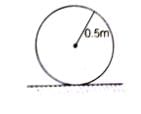
Therefore,

Therefore,
Angular acceleration = α = 2 rad/s2
Angular speed, ω = αt = 4 rad/s
Centripetal acceleration, ac = ω2r
42 x 0.5
=16 x 0.5
= 8m/s2
Linear acceleration at the end of 2 s is,
at = αt = 2 x 0.5 = 1 m/s2
Therefore, the net acceleration at the end of 2.0 sec is given by
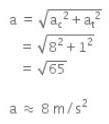
A uniform rod of length L and mass M is bent to make a reactangle PQRS such that QR/PQ = 1/2 Moment of inertia of the rectangle about the side QR can be expressed as :
- a)

- b)

- c)

- d)

Correct answer is option 'D'. Can you explain this answer?
A uniform rod of length L and mass M is bent to make a reactangle PQRS such that QR/PQ = 1/2 Moment of inertia of the rectangle about the side QR can be expressed as :
a)
b)
c)
d)

|
Sushil Kumar answered |
Firstly, using the relations given in the questions, we will find the length and mass of the parts

A rigid body is one
- a)the sum of distances of all particles from the axis remains constant
- b)in which the distance between all pairs of particles remains fixed
- c)whose centre of mass follows a parabolic path
- d)that deforms and comes back to its original shape after getting deformed
Correct answer is option 'B'. Can you explain this answer?
A rigid body is one
a)
the sum of distances of all particles from the axis remains constant
b)
in which the distance between all pairs of particles remains fixed
c)
whose centre of mass follows a parabolic path
d)
that deforms and comes back to its original shape after getting deformed
|
|
Krishna Iyer answered |
A body is said to be a rigid body if the body remains in its original shape even under the influence of external force. We can also say that if distance between two points of the body does not change with time regardless of external forces exerted on it, then the body is said to be a rigid body.
A boy hits a baseball with a bat and imparts an impulse J to the ball. The boy hits the ball again with the same force, except that the ball and the bat are in contact for twice the amount of time as in the first hit. The new impulse equals.- a)half the original impulse
- b)the original impulse
- c)twice the original impulse
- d)four times the original impulse
Correct answer is option 'C'. Can you explain this answer?
A boy hits a baseball with a bat and imparts an impulse J to the ball. The boy hits the ball again with the same force, except that the ball and the bat are in contact for twice the amount of time as in the first hit. The new impulse equals.
a)
half the original impulse
b)
the original impulse
c)
twice the original impulse
d)
four times the original impulse
|
|
Hansa Sharma answered |
J = Ft
1) J = Ft1
2) J = F x 2t1
Hence impulse also gets doubled because impulse is dependent upon time
1) J = Ft1
2) J = F x 2t1
Hence impulse also gets doubled because impulse is dependent upon time
An earth satellite is moving around the earth in a circular orbit. In such case, what is conserved?- a)angular momentum
- b)force
- c)linear momentum
- d)velocity
Correct answer is option 'A'. Can you explain this answer?
An earth satellite is moving around the earth in a circular orbit. In such case, what is conserved?
a)
angular momentum
b)
force
c)
linear momentum
d)
velocity
|
|
Preeti Iyer answered |
Angular Momentum is conserved
Mvr = constant
We can say that v is proportional to 1/r. When satellite stays near earth then velocity of the satellite is maximum.
Mvr = constant
We can say that v is proportional to 1/r. When satellite stays near earth then velocity of the satellite is maximum.
Calculate the M.I. of a thin uniform ring about an axis tangent to the ring and in a plane of the ring, if its M.I. about an axis passing through the centre and perpendicular to plane is 4 kg m2.- a)12 kg m2
- b)3 kg m2
- c)6 kg m2
- d)9 kg m2
Correct answer is option 'C'. Can you explain this answer?
Calculate the M.I. of a thin uniform ring about an axis tangent to the ring and in a plane of the ring, if its M.I. about an axis passing through the centre and perpendicular to plane is 4 kg m2.
a)
12 kg m2
b)
3 kg m2
c)
6 kg m2
d)
9 kg m2
|
|
Naina Sharma answered |
At tangent I =MR2/2 + MR2 --- (1)
MR2/2 = 4, MR2 = 8 then substitute in (1) you will get I = 12, this is for tangent perpendicular to plane then divide by 2 you will get tangent along the plane
MR2/2 = 4, MR2 = 8 then substitute in (1) you will get I = 12, this is for tangent perpendicular to plane then divide by 2 you will get tangent along the plane
A uniform square plate ABCD has a mass of 10kg. If two point masses of 3 kg each are placed at the corners C and D as shown in the adjoining figure, then the centre of mass shifts to the point which is lie on- 
- a)OC
- b)OD
- c)OY
- d)OX
Correct answer is option 'C'. Can you explain this answer?
A uniform square plate ABCD has a mass of 10kg. If two point masses of 3 kg each are placed at the corners C and D as shown in the adjoining figure, then the centre of mass shifts to the point which is lie on-
a)
OC
b)
OD
c)
OY
d)
OX

|
Imk Pathsala answered |
∵ initial center of mass stays at the center of the square plate. When the mass (20 g) are placed at B and C, the shift along 'y' direction is Zero.
It moves towards the line OY
It moves towards the line OY
Two billiard balls undergo a head-on collision. Ball 1 is twice as heavy as ball 2. Initially, ball 1 moves with a speed v towards ball 2 which is at rest. Immediately after the collision, ball 1 travels at a speed of v/ 3 in the same direction. What type of collision has occured ?- a)inelastic
- b)elastic
- c)completely inelastic
- d)Cannot be determined from the information given
Correct answer is option 'B'. Can you explain this answer?
Two billiard balls undergo a head-on collision. Ball 1 is twice as heavy as ball 2. Initially, ball 1 moves with a speed v towards ball 2 which is at rest. Immediately after the collision, ball 1 travels at a speed of v/ 3 in the same direction. What type of collision has occured ?
a)
inelastic
b)
elastic
c)
completely inelastic
d)
Cannot be determined from the information given
|
|
Krishna Iyer answered |
First solve the equation of conservation of momentum which gives us that the relative velocity of approach is equal to the relative velocity of separation. Hence coefficient of restitution is 1. That means the collision is elastic.
mv2 + 2mv3 = 2mv + m0
- v2 = 4v3
- e = 4v3 − v3v – 0
- e = 1
Two particles having mass ratio n : 1 are interconnected by a light inextensible string that passes over a smooth pulley. If the system is released, then the acceleration of the centre of mass of the system is :- a)(n _1)2 g
- b)

- c)

- d)

Correct answer is option 'C'. Can you explain this answer?
Two particles having mass ratio n : 1 are interconnected by a light inextensible string that passes over a smooth pulley. If the system is released, then the acceleration of the centre of mass of the system is :
a)
(n _1)2 g
b)
c)
d)

|
Learners Habitat answered |
Given 
Each mass will have the acceleration
However m1 which is heavier will have the will have acceleration a1 vertically down while the lighter mass m2 will have acceleration a2 vertically up → a2=−a1
The acceleration of the center of mass of the system,
Given that

Since diving by m2 and simplifying
diving by m2 and simplifying 
Hence c is the correct answer

Each mass will have the acceleration

However m1 which is heavier will have the will have acceleration a1 vertically down while the lighter mass m2 will have acceleration a2 vertically up → a2=−a1
The acceleration of the center of mass of the system,

Given that

Since
 diving by m2 and simplifying
diving by m2 and simplifying 
Hence c is the correct answer
The M.I. of a disc about its diameter is 2 units. Its M.I. about axis through a point on its rim and in the plane of the disc is- a)4 unit
- b)6 unit
- c)8 unit
- d)10 unit
Correct answer is option 'D'. Can you explain this answer?
The M.I. of a disc about its diameter is 2 units. Its M.I. about axis through a point on its rim and in the plane of the disc is
a)
4 unit
b)
6 unit
c)
8 unit
d)
10 unit
|
|
Krishna Iyer answered |
We know that for a disc of mass m and radius r
MI of a disc about its diameter = mr2/4 = 2
And also MI about a point on its rim = mr2/4 + mr2
= 5mr2/4
= 5 x 2 = 10
MI of a disc about its diameter = mr2/4 = 2
And also MI about a point on its rim = mr2/4 + mr2
= 5mr2/4
= 5 x 2 = 10
A CD accelerates uniformly from rest to 200 spins per minute in 8 seconds. If the rate of change of speed is constant, determine the instantaneous acceleration in rad/s2 .- a)200.2 π rad/s2
- b)25 rad/ s2
- c)20.9 rad/ s2
- d)2.6 rad/ s2
Correct answer is option 'D'. Can you explain this answer?
A CD accelerates uniformly from rest to 200 spins per minute in 8 seconds. If the rate of change of speed is constant, determine the instantaneous acceleration in rad/s2 .
a)
200.2 π rad/s2
b)
25 rad/ s2
c)
20.9 rad/ s2
d)
2.6 rad/ s2
|
|
Varun Kapoor answered |
The correct option is A
2.6 rad/ s2
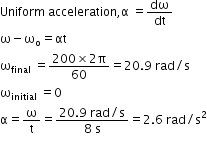
The moment of inertia and rotational kinetic energy of a fly wheel are 20kg-m2 and 1000 joule respectively. Its angular frequency per minute would be -- a)600/π
- b)25/π2
- c)5/π
- d)300/π
Correct answer is option 'D'. Can you explain this answer?
The moment of inertia and rotational kinetic energy of a fly wheel are 20kg-m2 and 1000 joule respectively. Its angular frequency per minute would be -
a)
600/π
b)
25/π2
c)
5/π
d)
300/π
|
|
Riya Banerjee answered |
Rotational K.E. = ½ × moment of inertia × square of angular velocity = ½Iw2
A mixer grinder rotates clockwise, its angular velocity will be :- a)zero
- b)negative
- c)uniform but not zero
- d)positive
Correct answer is option 'B'. Can you explain this answer?
A mixer grinder rotates clockwise, its angular velocity will be :
a)
zero
b)
negative
c)
uniform but not zero
d)
positive
|
|
Ashish Roy answered |
**Explanation:**
A mixer grinder is a device that is used for grinding and mixing various ingredients. It consists of a motor and a set of blades that rotate at high speeds to perform the grinding and mixing tasks. When the mixer grinder is turned on, the motor starts rotating the blades in a clockwise direction.
**Angular Velocity:**
Angular velocity is a measure of how quickly an object rotates or moves around a central point. It is defined as the rate of change of angular displacement with respect to time. The direction of the angular velocity is determined by the direction of rotation. In the case of a mixer grinder rotating clockwise, the angular velocity will be negative.
**Direction of Angular Velocity:**
The direction of angular velocity is determined by the right-hand rule. According to the right-hand rule, if the fingers of the right hand curl in the direction of rotation, the thumb will point in the direction of the angular velocity vector. In the case of a mixer grinder rotating clockwise, the fingers of the right hand curl in the clockwise direction, and the thumb points in the opposite direction, which is counterclockwise or negative.
**Significance of Negative Angular Velocity:**
A negative angular velocity indicates that the object is rotating in the opposite direction compared to the conventional positive direction. In the case of a mixer grinder, a negative angular velocity means that the blades are rotating counterclockwise when viewed from above. This counterclockwise rotation is necessary for the blades to effectively grind and mix the ingredients.
**Conclusion:**
In conclusion, a mixer grinder rotates clockwise, which means its angular velocity will be negative. The negative angular velocity indicates that the blades are rotating counterclockwise when viewed from above, allowing them to efficiently perform the grinding and mixing tasks.
A mixer grinder is a device that is used for grinding and mixing various ingredients. It consists of a motor and a set of blades that rotate at high speeds to perform the grinding and mixing tasks. When the mixer grinder is turned on, the motor starts rotating the blades in a clockwise direction.
**Angular Velocity:**
Angular velocity is a measure of how quickly an object rotates or moves around a central point. It is defined as the rate of change of angular displacement with respect to time. The direction of the angular velocity is determined by the direction of rotation. In the case of a mixer grinder rotating clockwise, the angular velocity will be negative.
**Direction of Angular Velocity:**
The direction of angular velocity is determined by the right-hand rule. According to the right-hand rule, if the fingers of the right hand curl in the direction of rotation, the thumb will point in the direction of the angular velocity vector. In the case of a mixer grinder rotating clockwise, the fingers of the right hand curl in the clockwise direction, and the thumb points in the opposite direction, which is counterclockwise or negative.
**Significance of Negative Angular Velocity:**
A negative angular velocity indicates that the object is rotating in the opposite direction compared to the conventional positive direction. In the case of a mixer grinder, a negative angular velocity means that the blades are rotating counterclockwise when viewed from above. This counterclockwise rotation is necessary for the blades to effectively grind and mix the ingredients.
**Conclusion:**
In conclusion, a mixer grinder rotates clockwise, which means its angular velocity will be negative. The negative angular velocity indicates that the blades are rotating counterclockwise when viewed from above, allowing them to efficiently perform the grinding and mixing tasks.
A super-ball is to bounce elastically back and forth between two rigid walls at a distance d from each other. Neglecting gravity and assuming the velocity of super-ball to be v0 horizontally, the average force being exerted by the super-ball on each wall is :- a)

- b)

- c)

- d)

Correct answer is option 'B'. Can you explain this answer?
A super-ball is to bounce elastically back and forth between two rigid walls at a distance d from each other. Neglecting gravity and assuming the velocity of super-ball to be v0 horizontally, the average force being exerted by the super-ball on each wall is :
a)
b)
c)
d)
|
|
Naina Sharma answered |
Change in momentum when ball strikes one wall is:
Δp= −mv0−m(v0) = −2mv0
The time it takes to come back and hit the wall again is:
t=−2d/v0
Hence force applied is Δp/t=mv20/d
Δp= −mv0−m(v0) = −2mv0
The time it takes to come back and hit the wall again is:
t=−2d/v0
Hence force applied is Δp/t=mv20/d
Four point masses, each of value m, are placed at the corners of a square ABCD of side l. The moment of inertia of this system about an axis passing through A and parallel to BD is
- a) 3 ml2
- b) ml2
- c) 2 ml2
- d) √3 ml2
Correct answer is option 'A'. Can you explain this answer?
Four point masses, each of value m, are placed at the corners of a square ABCD of side l. The moment of inertia of this system about an axis passing through A and parallel to BD is
a)
3 ml2b)
ml2c)
2 ml2d)
√3 ml2|
|
Raghav Bansal answered |
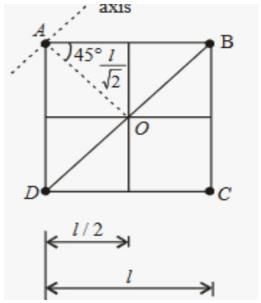
IA=0 (on the Axis .)
IB=ID=mr2
=m(l/√2)2
=ml2/2
IC=m(√2l)2
IC=2ml2
I=IA+IB+IC+ID
I=0+ml2/2+ml2/2+2ml2
I=3ml2
An automobile engine develops 100H.P. when rotating at a speed of 1800 rad/min. The torque it delivers is- a)3.33 W-s
- b)200W-s
- c)248.7 W-s
- d)2487 W-s
Correct answer is option 'D'. Can you explain this answer?
An automobile engine develops 100H.P. when rotating at a speed of 1800 rad/min. The torque it delivers is
a)
3.33 W-s
b)
200W-s
c)
248.7 W-s
d)
2487 W-s

|
Manish Aggarwal answered |
100 HP = 74570 W or 74.57 KW Now, P = 2*π*N*T/60 where, P is the power (in W), N is the operating speed of the engine (in r.p.m.) and T is the Torque (in N.m). Therefore, 74570 = 2*π*1800*T/60 i.e. T = 395.606 N.m
Two spheres of masses m1 and m2 (m1>m2) respectively are tied to the ends of a light, inextensible string which passes over a light frictionless pulley. When the masses are released from their initial state of rest, the acceleration of their centre of mass is: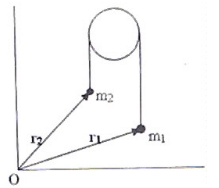
- a)

- b)

- c)

- d)

Correct answer is option 'C'. Can you explain this answer?
Two spheres of masses m1 and m2 (m1>m2) respectively are tied to the ends of a light, inextensible string which passes over a light frictionless pulley. When the masses are released from their initial state of rest, the acceleration of their centre of mass is:
a)
b)
c)
d)

|
Sushil Kumar answered |
If, r1 and r2 are position vectors of the centres of the positional vector of their centre of mass is given by R=(m1r1+m2r2)/ (m1 + m2)
R= (m1r2+m2r2)/m1+m2)
The acceleration of the centre of mass is given by:
A=d2R/dt
= [m1 d2r/dt+m2 d2r/dt2 ]/(m1+m2)
But, d2r1/dt2 and d2r2/dt2 are the accelerations of masses m1 and m2
Have the same magnitude (m1-m2)/(m1+m2) g
If we take acceleration of [m1(m1-m2)/ (m1+m2)g – m2(m1-m2)/ (m1+m2)/]/ (m1+m2)
On simplifying that we get,
a=[(m1-m2)/ (m1+m2)]2 g
R= (m1r2+m2r2)/m1+m2)
The acceleration of the centre of mass is given by:
A=d2R/dt
= [m1 d2r/dt+m2 d2r/dt2 ]/(m1+m2)
But, d2r1/dt2 and d2r2/dt2 are the accelerations of masses m1 and m2
Have the same magnitude (m1-m2)/(m1+m2) g
If we take acceleration of [m1(m1-m2)/ (m1+m2)g – m2(m1-m2)/ (m1+m2)/]/ (m1+m2)
On simplifying that we get,
a=[(m1-m2)/ (m1+m2)]2 g
Chapter doubts & questions for System of Particles and Rotational Motion - NCERT Based Tests for NEET 2025 is part of NEET exam preparation. The chapters have been prepared according to the NEET exam syllabus. The Chapter doubts & questions, notes, tests & MCQs are made for NEET 2025 Exam. Find important definitions, questions, notes, meanings, examples, exercises, MCQs and online tests here.
Chapter doubts & questions of System of Particles and Rotational Motion - NCERT Based Tests for NEET in English & Hindi are available as part of NEET exam.
Download more important topics, notes, lectures and mock test series for NEET Exam by signing up for free.

Contact Support
Our team is online on weekdays between 10 AM - 7 PM
Typical reply within 3 hours
|
Free Exam Preparation
at your Fingertips!
Access Free Study Material - Test Series, Structured Courses, Free Videos & Study Notes and Prepare for Your Exam With Ease

 Join the 10M+ students on EduRev
Join the 10M+ students on EduRev
|

|
Create your account for free
OR
Forgot Password
OR
Signup to see your scores
go up
within 7 days!
within 7 days!
Takes less than 10 seconds to signup

